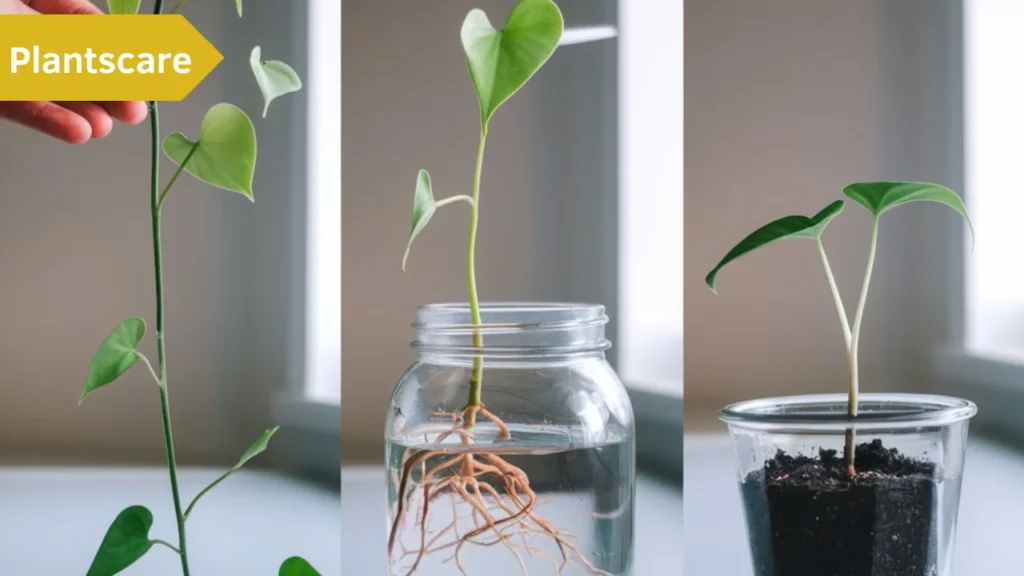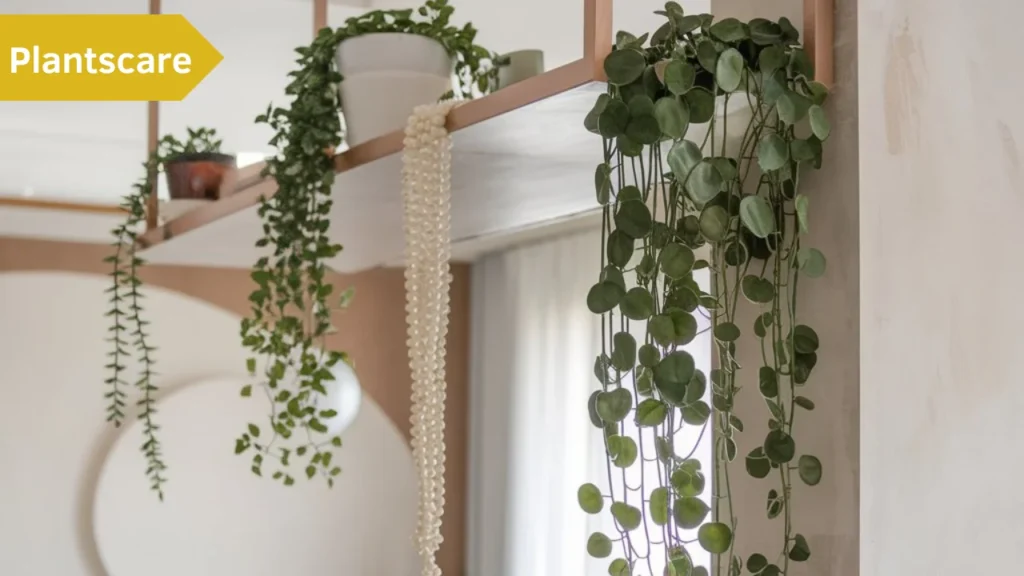The “Chain of hearts plant care” also known as Ceropegia woodii, is a trailing vine that captures the hearts of plant enthusiasts worldwide. Its delicate, heart-shaped leaves dangle beautifully from long, slender stems, creating a captivating display of greenery that adds charm to any indoor space. Originating from South Africa, this semi-succulent has evolved to tolerate drought and low humidity, making it a resilient and low-maintenance choice for beginners and experienced plant lovers alike.
Chain of hearts plant characteristics
The Chain of Hearts plant has an enchanting appearance that sets it apart from other houseplants. Its heart-shaped leaves are typically variegated, with shades of green, silver, and even a hint of purple on the underside. These leaves grow along thin, trailing stems that can reach impressive lengths, often cascading several feet when given the right conditions. Despite its delicate appearance, this plant is quite hardy and can adapt to a variety of indoor environments.
Growth habits and varieties
Though the classic variety of Ceropegia woodii is the most common, there are a few cultivars that offer slightly different features. The ‘String of Spades’ variety has pointed leaves, while ‘String of Hearts Silver Glory’ boasts a more pronounced silver hue on the leaves. The growth habit is slow but steady, making it an excellent choice for hanging baskets and shelves where its vines can spill gracefully over the sides.
Seasonal behavior
Like many plants, the Chain of Hearts has periods of active growth and dormancy. During the spring and summer months, you may notice quicker growth and more frequent watering needs. In contrast, fall and winter see the plant slow down, and it’s best to reduce watering during this time.
Essential care tips for chain of hearts
Light requirements
The Chain of Hearts thrives in bright, indirect light. A location with filtered sunlight next to a window is ideal. While too little light can result in lanky growth, too much direct sunshine can scorch the leaves. If you’re wondering whether it can survive in low light, the answer is yes, but its growth will be slower, and the leaves may lose some of their vibrant color.
Watering needs
The key to keeping your Chain of Hearts healthy is finding the right watering balance. As a semi-succulent, it prefers to dry out between waterings. It’s a good idea to water when the top inch of soil appears dry. Avoid overwatering your plants as this might cause root rot. Signs of overwatering include yellowing leaves and mushy stems, while underwatering will cause the leaves to shrivel and dry out.
Temperature and humidity
The ideal temperature range for this plant is between 60°F and 85°F (15°C to 29°C). It doesn’t tolerate frost, so keep it away from cold drafts in the winter. Humidity levels of 40-60% are ideal, though it can tolerate lower humidity, making it suitable for most indoor environments.
Soil type and repotting
Chain of Hearts plants prefer well-draining soil. A cactus or succulent mix works well, but you can also make your own by mixing regular potting soil with sand or perlite. Repotting is not frequently needed—only when the plant becomes root-bound or the soil quality degrades. It is adequate to repot every two to three years.
Propagating chain of hearts
Propagation is one of the most exciting aspects of Chain of Hearts care, allowing you to multiply your plant with ease.
Propagation methods
There are two main ways to propagate a Chain of Hearts: water propagation and soil propagation. Both methods are simple and effective, but water propagation tends to show results faster.
Step-by-step propagation guide

- Cut a healthy section of the vine, making sure there are at least two nodes (the spots where leaves meet the stem).
- For water propagation, place the cutting in a jar of water, making sure the nodes are submerged. You should start to see roots form in around two weeks.
- For soil propagation, you can plant the cutting directly into moist soil, ensuring the nodes are under the surface.
- Keep the cuttings in a warm, bright spot, and in a few weeks, you’ll have a new plant!
Fertilizing your chain of hearts
During the growing season (spring and summer), feed your plant every four to six weeks with a balanced liquid fertilizer diluted to half strength. Avoid over-fertilizing, as this can cause salt buildup in the soil and damage the roots.
Common pests and diseases
Recognizing common pests
Though generally resilient, Chain of Hearts plants can fall victim to pests like spider mites, aphids, and mealybugs. If you notice tiny webs, sticky residue, or white, cotton-like masses, it’s time to take action.
Diseases and prevention tips
The most common disease issue with Chain of Hearts is root rot, which stems from overwatering. Ensure proper drainage and avoid letting your plant sit in water to prevent this problem.
Troubleshooting common issues
Yellowing leaves
Yellow leaves can be a sign of overwatering, poor light conditions, or nutrient deficiencies. Examine your plant’s surroundings and make the necessary adjustments.
Leggy growth
If your plant is growing leggy, it’s likely not receiving enough light. Move it to a brighter spot to encourage fuller, more compact growth.
Root rot
Poor drainage or overwatering are the main causes of root rot. Remove the impacted roots and repot the plant in new, well-draining soil if you believe it has root rot.
How to revive a dying chain of hearts
If your Chain of Hearts seems on the brink of death, don’t despair! Check the roots for rot, cut back any dead or damaged vines, and adjust watering practices. With time and care, many plants can bounce back.
Decorative ideas and styling with chain of hearts
The trailing vines of the Chain of Hearts make it a perfect candidate for hanging planters, shelves, or macrame plant hangers. Combine it with other trailing plants like String of Pearls or Spider Plants for a lush, cascading effect in your living space.

Seasonal care guide
Spring and summer care
During the warmer months, your Chain of Hearts will be in active growth. This is the time to water more frequently and consider fertilizing to encourage healthy development.
Fall and winter care
In the cooler months, the plant will enter dormancy. Watering should be reduced, and fertilizing can be stopped altogether.
Benefits of having a chain of hearts plant
Apart from being a stunning addition to your home, the Chain of Hearts has air-purifying qualities that can help improve indoor air quality. Additionally, the act of caring for plants has been shown to reduce stress and boost mood, making it a win-win for your mental health and home décor.
Conclusion
The Chain of Hearts plant is a delightful, low-maintenance addition to any indoor garden. With the right care, its heart-shaped leaves and cascading vines can thrive for years, bringing beauty and joy into your home.
FAQs
How fast does the chain of hearts grow?
The Chain of Hearts grows relatively slowly, but during the active growing season, you can expect several inches of new growth each month.
Can the chain of hearts plant survive outdoors?
In warmer climates, it can be grown outdoors in a shaded area, but it’s best kept indoors in cooler regions.
Is the chain of hearts plant toxic to pets?
The Chain of Hearts is considered non-toxic to pets, making it a safe choice for households with cats and dogs.
What are the signs of a healthy chain of hearts plant?
Healthy plants will have vibrant, firm leaves and steady growth with no signs of yellowing, wilting, or pest infestations.
How long does a chain of hearts plant live?
With proper care, the Chain of Hearts can live for many years, continuing to grow and produce new vines over time.